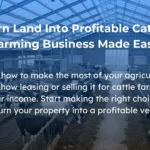Introduction:
Technology in Agriculture matters. It is very time-consuming, labor-intensive, and open to inefficiencies. Are you tired of traditional farming? The future of agriculture is here, and it is packed with modern technologies that are transforming in a way that is good. Modernistic agriculture is not about fields and plows it’s about precision, automation, and data. In this article, we will explore the key technologies that are transforming the agriculture landscape making farming efficient and renewable. Precision agriculture is important.
At Al Arz, We provide agriculture services from getting hold of fertile land to managing renewable farming practices. Our team of experts is here to support you in achieving the agriculture goals for more information visit our agriculture land page.
Precision Agriculture
Precision agriculture includes using technology to change farming practices by customizing the management of crop to field conditions. This will help farmers to apply inputs such as pesticides, fertilizer, and water more efficiently resulting in higher yields and lower costs.
Tools
GPS-Enabled Equipment
GPS is the technology that guides equipment such as tractors with pinpoint accuracy and reduces the overlaps and areas that are missed during spraying and planting.
Drones
Drones provide elevated views of fields. It helps farmers monitor crop health, assess damage, and make informed decisions about crop management.
Sensors
In soil, the sensors are placed to measure the temperature, moisture, and nutrient levels giving the farmers the opportunity to make data-driven decisions about fertilization and irrigation.
Yield Monitors
Yield Monitors are the devices that are used to measure crop yields in real-time harvesting. It provides insights into field performance and allows farmers to make complete adjustments for future planting seasons.
Automation and Robotics
Robotics and Automation are adjusting agriculture by lessening labor costs, minimizing human error, and increasing efficiency. These are the technologies that are particularly important in forwarding labor shortages and increasing the accuracy of farming tasks.
Tools
Autonomous Tractors
These are the tractors that can work without human interference. It performs tasks like planting, plowing, and harvesting with high accuracy.
Robotic Harvesters
Robotic harvesters are robots that can pick vegetables and fruits precisely. It increases the speed of harvesting and lessens the need for labor.
Robotic Weeders
Robotic weeders are robots that are used for identifying and removing weeds without damaging the crops and lessening the need for chemical herbicides.
Internet of Things (IoT) in Agriculture
The Internet of Things allows farmers to link various devices and sensors. Real-time monitoring and data collection on environmental conditions, equipment performance, and crop health can be done by using it.
Tools
IoT Sensors
IoT sensors are placed on the farm that can monitor the temperature, moisture of soil, humidity, and many other environmental factors. It helps farmers optimize irrigation and other inputs.
Data Loggers
These are the devices that collect data from sensors and it moves it to a central system for analysis, providing information that helps farmers make informed decisions.
Wireless Connectivity
Wireless networks are used to connect the IoT devices across the farm. It ensures seamless data flow and communication which is important for real-time decision-making.
Artificial Intelligence (AI) and Machine Learning
Artificial Intelligence and Machine Learning are powerful tools for investigating large volumes of agricultural data. The prediction of crop yields and detection of diseases early can be made by it. It leads to more accurate and profitable farming.
Tools:
AI-Powered Image Recognition Software
The images of crops are analyzed by these tools to detect pests, nutrient deficiencies, and diseases.
Predictive Analytics Platforms
These tools use historical data to forecast crop yields, market trends, and weather conditions. It helps farmers to plan more accurately.
Machine Learning Algorithms
Machine learning algorithms learn from data continuously. It improves the recommendations over time and the accuracy of predictions.
Blockchain Technology
One of the secure ways to track the food supply chain is blockchain technology. It ensures traceability and it reduces the risk of fraud. This technology develops trust between suppliers, farmers, and customers by providing records of each part of the production process.
Tools
Blockchain Platforms
Blockchain platforms are used to store the data on a ledger. It makes it attainable to all of the parties in the supply chain while it ensures data integrity.
Smart Contracts
Smart contracts are used to execute the agreements that are based on the conditions as it reduces the need for speeding up the transactions.
Data Traceability Systems
Data traceability is the system that tracks the movements of products from farm to table. It provides transparency and it also helps to verify the quality and origin of food.
Vertical Farming
The farming in which the indoor crops are included is known as vertical farming. This environment is used to maximize space and resources. This helps you with the yearly production and it also reduces water usage and also deletes the need for pesticides.
Tools
LED Grow Lights
In LED Grow light you can grow the plant without natural sunlight. It provides the spectrum of light for plant growth.
Hydroponic Systems
Hydroponic systems don’t use soil to grow plants because they use nutrient-rich water. It increases efficiency and it also lessens the need for large amounts of land.
Climate Control Equipment:
Climate Control Equipment is the system that is used to manage the humidity, CO2 levels, humidity, and the ideal environment for plant growth can be created.
Gene Editing
This is the technique that allows scientists to make precise changes to the DNA of plants. It improves crop yields, resistance to diseases, and nutritional value.
Tools
CRISPR-Cas9 Gene Editing Technology
This is a tool that enables editing of the plant’s genetic code. It allows for the improvement without the need for traditional crossbreeding.
Gene Sequencing Equipment
The gene sequencing equipment technology helps to identify the traits in plants. It gives us the gene editing process.
Bioinformatics Tools
Bioinformatics tools are used to analyze the genetic data. It helps the researchers to understand how different genes affect development and growth.
Conclusion
Technology is playing a very transformative role in agriculture. It drives efficiency, profitability, and sustainability. These tools are helping the farmers to overcome traditional challenges. The future of farming looks increasing.
Start your journey today with Al Arz and feel free to Contact us.
FAQs
Explain the difference between precision agriculture and smart farming.?
The technology to optimize specific farming practices is known as precision agriculture and smart farming allows a broader range of technology to improve accuracy.
What is the working of drones that can be used in agriculture?
The drones are used for the monitoring of crops, mapping fields, and spraying pesticides. It provides valuable insights and data to help farmers to make informed decisions.
What is the importance of using AI in agriculture?
AI is used to predict crop yields, optimize resources, and detect diseases easily.
It leads to increased efficiency and profitability.
How can farmers access these technologies?
These technologies can be accessed by farmers through various channels such as leasing, renting, or partnering with technology providers.
What are the key benefits of using technology in agriculture to improve farm efficiency?
Technology in agriculture offers several benefits, including precision in farming, efficient resource management, increased crop yields, and reduced labor costs, all contributing to more sustainable and profitable farming practices.









